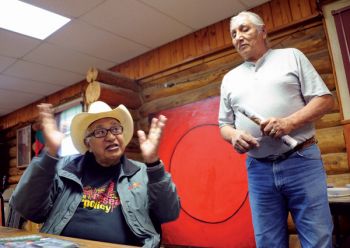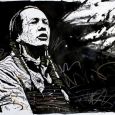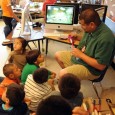The Gift of South Dakota
Subscriptions to South Dakota Magazine make great gifts!
Subscribe today — 1 year (6 issues) is just $29!
“They Laughed at Me”
Jun 21, 2013
It’s impossible to measure the impact of the death of Albert White Hat, who passed away on the Rosebud Indian Reservation last week at age 74. For more than half his life, White Hat worked tirelessly to ensure that his native Lakota language did not disappear, and that traditional Lakota ways of life were passed to the youngest generation.
White Hat learned the old ways from elders living in the tiny Spring Creek community on the outskirts of Saint Francis, where White Hat grew up. There, he was immersed in traditional culture. Every evening he sat at the feet of tribal elders and listened to their stories. He spoke nothing but Lakota until he entered a Jesuit boarding school. “I came from a community where we sang and danced and did everything in our language,” White Hat told us in 2009. “I walked into that institution and my peers were making fun of us, the ones from the country, for being big Indians, savages. And they were all Indian kids. Many years later, I found out they had been in that institution since they were 5. By the time they were teenagers they were conditioned to deny their Indian heritage.”
It caused White Hat to briefly turn against his own culture. Not until the 1960s, when he reconnected with medicine men practicing traditional ceremonies in secret, did he regain pride in his heritage. He especially found comfort in the Lakota language.
But there were overt efforts by the government throughout the 1900s to suppress the language and Lakota culture. Those restrictions weren’t fully lifted until Congress passed the American Indian Religious Freedom Act in 1978. When his children began school in the Todd County district, White Hat discovered there was no Lakota studies program. He thought it important for his children to learn their heritage, so he lobbied to start a Lakota language and history program. “They really gave me a bad time,” he said. “None of them would accept it. They laughed at me. Finally they said, ‘You can have a half an hour during noon hour to play your tape and dance.’”
Soon White Hat was teaching Lakota studies part-time at Saint Francis and Sinte Gleska University, which opened in Mission in 1971. He had no teaching experience; he relied only on his own notes for lectures and upon other teachers for help putting together lesson plans. Nevertheless, he continued until the university hired him full-time in 1983.
He eventually rose to lead the college’s Lakota studies department, striving to save a language that was gradually slipping away. Scholars consider Lakota an endangered language. Its fluent speakers are rapidly aging, and children aren’t learning the language quickly enough to replace them.
Today, organizations like the Lakota Language Consortium are establishing immersion schools, classes and producing books and tapes to help youth on the reservation learn Lakota. But White Hat was ahead of everyone when he wrote his Lakota language textbook in 1999. Jael Kampfe, a Montana native who was attending Yale University, began recording White Hat’s classes in 1992. Then they transcribed and edited them into a 226-page book. Even though the text contained information gleaned from White Hat’s 50 years of personal experience with the language, reviews were mixed when he sent a manuscript to linguists and publishers. “The language developed what they called a subculture,” White Hat said. “Historians and anthropologists use modern translations, and my work contradicted that. They didn’t want that printed.” One publisher told White Hat that, “folk etymology and oral history are fine, but they’re not recorded, so this shouldn’t be printed.”
The University of Utah Press finally published it in 1999, and it’s still used in classrooms around the country. Even though the teacher is gone, his knowledge and his words survive. And the next generation of Lakota speakers is grateful.











Comments
white hat. And Bless the white hat Family. We give our condolences and god bless you all. Take care. The Griffin Family: Mrs. Lisa(White Feather), Miss Katy Sue -(Raindrop), Miss Sabrina (Little Snow Flake),Mr. Wally Griffin-(Warrior Eagle).